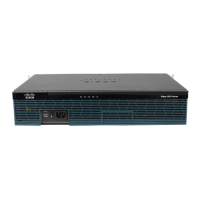182
Cisco 3900 Series, Cisco 2900 Series, and Cisco 1900 Series Integrated Services Routers Generation 2 Software Configuration Guide
Chapter Unified Communications on Cisco Integrated Services Routers
Online Insertion and Removal
TAPI
The standard Cisco Unified TAPI provides an unchanging programming interface for different
implementations. The goal of Cisco in implementing TAPI for the Cisco Unified Communications
Manager platform remains to conform as closely as possible to the TAPI specification, while providing
extensions that enhance TAPI and expose the advanced features of Cisco Unified Communications
Manager to applications.
See Basic TAPI Implementation at Cisco.com for information,
http://www.cisco.com/en/US/docs/voice_ip_comm/cucm/tapi_dev/7_0_1/tpdevch4.html
AXL
The AXL API provides a mechanism for inserting, retrieving, updating, and removing data from the
Cisco Unified Communications Manager database by using an eXtensible Markup Language (XML)
Simple Object Access Protocol (SOAP) interface. This approach allows a programmer to access the
database by using XML and receive the data in XML form, instead of by using a binary library or DLL.
The AXL API methods, known as requests, use a combination of HTTPS and SOAP. SOAP is an XML
remote procedure call (RPC) protocol. The server receives the XML structures and executes the request.
If the request completes successfully, the system returns the appropriate AXL response. All responses
are named identically to the associated requests, except that the word “Response” is appended.
See Cisco Unified Communications Manager XML Developers Guide Release 7.0(1) at Cisco.com for
information,
http://www.cisco.com/en/US/docs/voice_ip_comm/cucm/devguide/7_0_1/ccmdvCh1.html.
Gatekeeper Transaction Message Protocol (GKTMP)
The Cisco Gatekeeper Transaction Message Protocol (GKTMP) and application programming interface
(API) is available for your use.
See GKTMP Commands (GK API Guide Version 4.4 at Cisco.com for the latest Gatekeeper API inputs
and outputs, http://www.cisco.com/en/US/docs/ios/12_3/gktmpv4_3/guide/gk_cli.html.
Online Insertion and Removal
Online insertion and removal (OIR) is a feature that allows you to replace modules without turning off
the router and without affecting the operation of other interfaces. OIR of a module provides
uninterrupted operation to network users, maintains routing information, and ensures session
preservation.
For instructions on inserting, removing, and replacing the module, see the hardware installation guide
for your router at Cisco.com.

